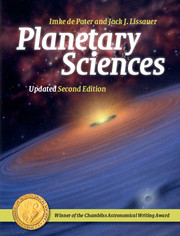Book contents
- Frontmatter
- Contents
- List of Tables
- Preface
- 1 Introduction
- 2 Dynamics
- 3 Solar Heating and Energy Transport
- 4 Planetary Atmospheres
- 5 Planetary Surfaces
- 6 Planetary Interiors
- 7 Magnetic Fields and Plasmas
- 8 Meteorites
- 9 Minor Planets
- 10 Comets
- 11 Planetary Rings
- 12 Extrasolar Planets
- 13 Planet Formation
- Appendix A List of Symbols Used
- Appendix B Acronyms Used
- Appendix C Units and Constants
- Appendix D Periodic Table of Elements
- Appendix E Observing Techniques
- Appendix F Interplanetary Spacecraft
- Appendix G Recent Developments in Planetary Sciences
- References
- Index
- Plate Section
- References
6 - Planetary Interiors
Published online by Cambridge University Press: 05 January 2015
- Frontmatter
- Contents
- List of Tables
- Preface
- 1 Introduction
- 2 Dynamics
- 3 Solar Heating and Energy Transport
- 4 Planetary Atmospheres
- 5 Planetary Surfaces
- 6 Planetary Interiors
- 7 Magnetic Fields and Plasmas
- 8 Meteorites
- 9 Minor Planets
- 10 Comets
- 11 Planetary Rings
- 12 Extrasolar Planets
- 13 Planet Formation
- Appendix A List of Symbols Used
- Appendix B Acronyms Used
- Appendix C Units and Constants
- Appendix D Periodic Table of Elements
- Appendix E Observing Techniques
- Appendix F Interplanetary Spacecraft
- Appendix G Recent Developments in Planetary Sciences
- References
- Index
- Plate Section
- References
Summary
at somewhere between 0.6 and 0.5 of the radius, measured from the surface, a very marked and remarkable change in the nature of the material, of which the Earth is composed, takes place.
R.D. Oldham, 1913In the previous two chapters, we discussed the atmospheres and surface geology of planets. Both of these regions of a planet can be observed directly from Earth and/or space. But what can we say about the deep interior of a planet? We are unable to observe the inside of a planet directly. For the Earth and the Moon we have seismic data, revealing the propagation of waves deep below the surface and thereby providing information on the interior structure (§6.2). The interior structure of all other bodies is deduced through a comparison of remote observations with observable characteristics predicted by interior models. The relevant observations are the body's mass, size (and thus density), its rotational period and geometric oblateness, gravity field, characteristics of its magnetic field (or absence thereof), the total energy output, and the composition of its atmosphere and/or surface. Cosmochemical arguments provide additional constraints on a body's composition, while laboratory data on the behavior of materials under high temperature and pressure are invaluable for interior models. Quantum mechanical calculations are used to deduce the behavior of elements (especially hydrogen) at pressures inaccessible in the laboratory.
In this chapter we discuss the basics of how one can infer the interior structure of a body from the observed quantities. As expected, there are large differences between the interior structure of the giant planets, the terrestrial planets, and the icy moons. Moreover, even within each of these groupings there are noticeable differences in interior structure.
Modeling Planetary Interiors
Key observations used to extract information on the interior structure of a body are its mass, size, and shape. The mass and size together yield an estimate for the average density, which can be used directly to derive some first order estimates on the body's composition.
- Type
- Chapter
- Information
- Planetary Sciences , pp. 241 - 282Publisher: Cambridge University PressPrint publication year: 2015



